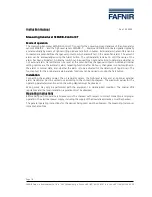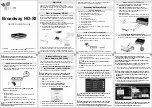
– –
– –
34
35
Using the CMD Line
The CMD line informs the module where incoming UART data should be
routed. When the line is high, all incoming UART data is treated as payload
data and is routed to the transmitter to be sent over the air. If the CMD line
is low, the incoming UART data is treated as command bytes and is routed
to the controller for processing.
Since the module’s controller looks at UART data one byte at a time, the
CMD line must be held low for the entire duration of the command plus
time for ten bits as margin for processing. Leaving the line low for additional
time (for example, until the ACK byte is received by the application) does
not adversely affect the module. If RF packets are received while the CMD
line is active, they are still processed and output on the module’s UART
(assuming CMDHOLD=0 and PKOPT:RXPKT=0). Figure 29 shows this
timing.
Commands can be entered sequentially without having to raise the CMD
line after each one. The CMD line just needs to be raised to be able to
enter data for transmission.
If the
register is 0x01 then any received data is held until the
CMD line is raised. This prevents received data from being intermingled
with command responses.
CMD_DATA_IN
CMD
D0
...
D6
D7
≥10 bit
times
Stop
Start
Figure 29: HumPRO-A
TM
Series Transceiver CMD Line Timing
AES Encryption
HumPRO
TM
Series modules with firmware version 2.0 and above offer AES
encryption. Encryption algorithms are complex mathematical calculations
that use a large number called a key to scramble data before transmission.
This is done so that unauthorized persons who may intercept the signal
cannot access the data. To decrypt the data, the receiver must use the
same key that was used to encrypt it. It performs the same calculations as
the transmitter and if the key is the same, the data is recovered.
The HumPRO
TM
Series module has the option to use AES encryption,
arguably the most common encryption algorithm on the market. This is
implemented in a secure mode of operation to ensure the secrecy of the
transmitted data. It uses a 128-bit key to encrypt the transmitted data. The
source and destination addresses are sent in the clear.
Encryption is disabled by default. There are two ways to enable encryption
and set the key: sending serial commands and using the JOIN process.
Writing an encryption key to the module with the CDI
The module has no network key when shipped from the factory. An
encryption key can be written to the module using the CDI. The
register is used to write or clear a key. The key cannot be read.
The same key must be written to all modules that are to be used together.
If they do not have the same key then they will not communicate in
encrypted mode.
The JOIN Process
The JOIN process is a method of generating an encryption key and
distributing the key and addresses to associated modules through a series
of button presses. This makes it very simple to establish an encrypted
network in the field or add new nodes to an existing network without any
additional equipment. It is also possible to trigger the JOIN process through
commands on the Command Data Interface.
The JOIN process configures a star network with the central unit as system
administrator. Other units are added to the network one at a time.
The hardware required is a pushbutton that is connected to the PB
line. This takes the line to VCC when it is pressed and ground when it
is released. An LED connected to the MODE_IND line provides visual
indication of the module’s state.
Содержание EVM-900-PRO
Страница 1: ...HumPRO ATM Series 900MHz RF Transceiver Module Data Guide...
Страница 60: ...114 115 Notes...
















































